The Huawei Ascend Mate 7 Review
by Andrei Frumusanu on December 2, 2014 8:00 AM EST- Posted in
- Smartphones
- Huawei
- Mobile
- Ascend Mate 7
- HiSilicon
CPU Performance
Let's a better look at the Kirin 925's performance in terms CPU power. Again, this SoC is merely a slightly higher clocked Hi3630 as we've already benchmarked on the Huawei Honor 6. The basic hardware remains the same - a 1.8GHz quad A15 cluster with 2MB of L2 and a 1.3GHz quad A7 cluster with 512kB of L2 cache. The setup is running on an HMP (Heterogeneous Multi-Processing) hardware implementation running on a Linaro GTS (Global Task Scheduling) software stack on the Linux kernel. Memory is provided by 2GB of LPDDR3-1600 memory in this unit, with a higher 3GB variant available.
First, we take a look at our browser suites, testing general Javascript performance inside Chrome.
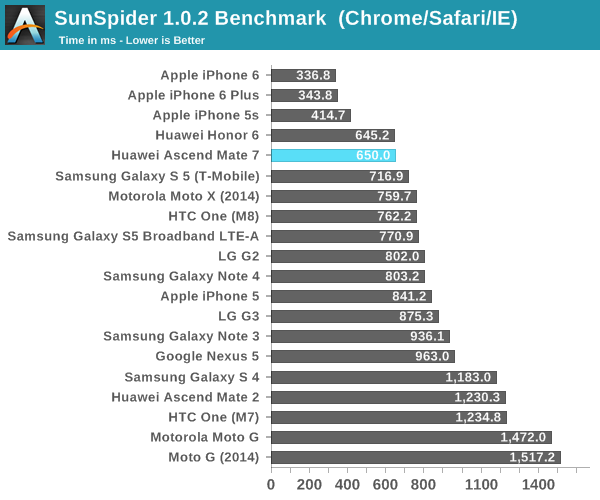
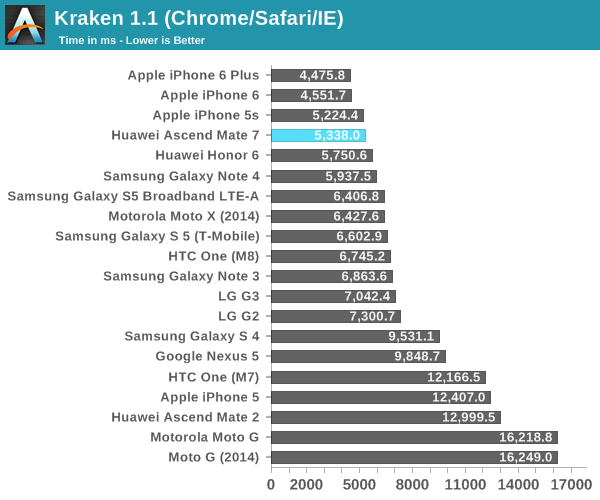
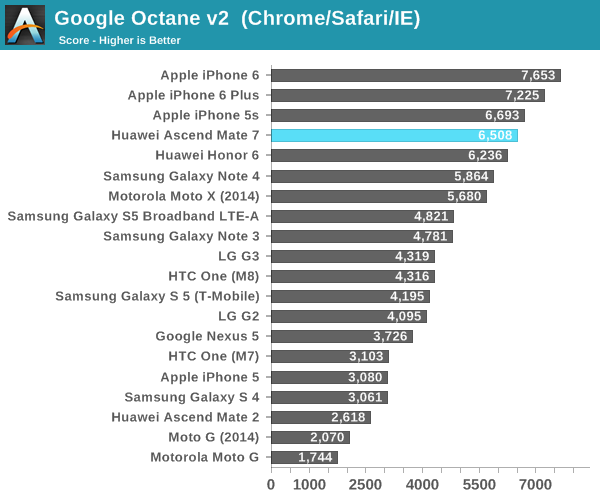
As expected, the Mate 7 doesn't differ too much from the Honor 6. The slight 100MHz boost on the A15 cluster brings it a few slight percentages above the Kirin 920. Again we see the big.LITTLE configuration and the A15 in general being extremely well-performing in these tests, being at the forefront of Android performance and only being beaten by Apple's own chip architectures. It's safe to say that the CPU has no issues at all in delivering an excellent and fast web-browsing experience.
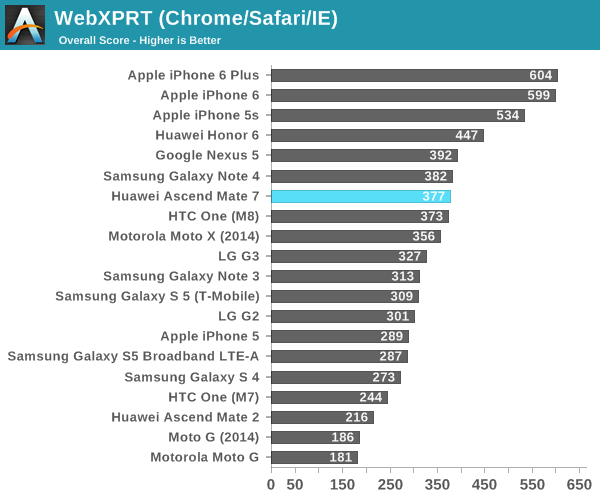
WebXPRT has behaved weirdly on the Mate 7, it consistently scores less than the Honor 6 even although they employ the same chip. I'm not too sure as why this happened. My assumption is that there might be some software regressions in Huawei's OS libraries, but it's weird to see WebXPRT being the sole test unit to suffer from this effect. Because the CPU is running at a higher clock and voltage, we might be seeing some problem with throttling as WebXPRT tends to run much longer than the previous benchmarks.
Let's continue on with BaseMark OS II, a benchmark which tries to measure several aspects of a system.
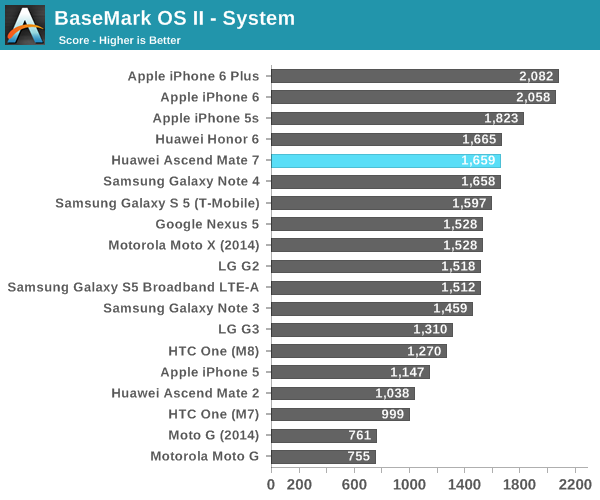
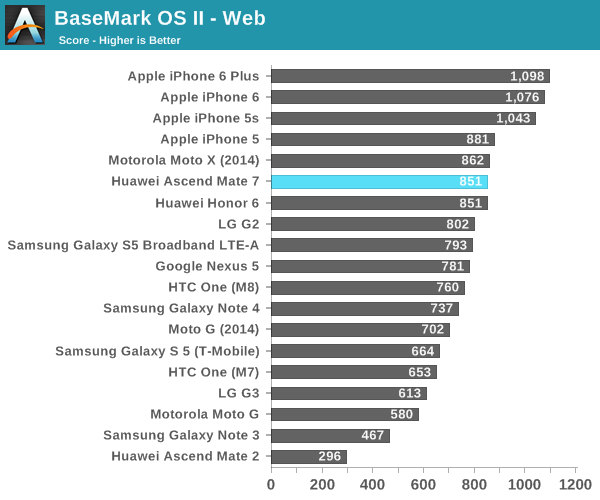
The System and Web tests in BaseMark are mainly CPU limited. We see a similar ordering as in the Javascript benchmarks, with the Kirin leading the Android devices behind Apple's iPhones.
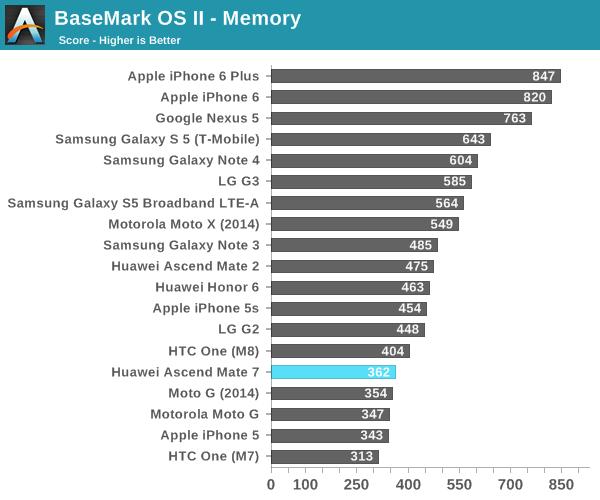
The memory benchmark is performing very weakly here. As a reminder, BaseMark is also testing the NAND performance in the memory sub-test, and not the main memory.
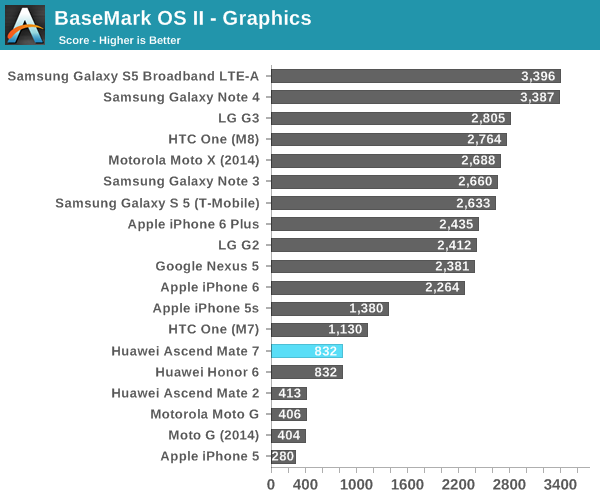
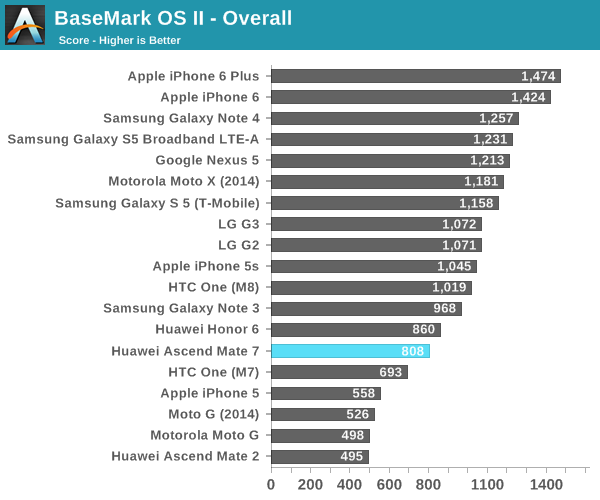
Like on the Honor 6, the Mali is having big issues with BaseMark OS II's Graphics benchmark and ends up below even Qualcomm's last generation's GPU. This, in conjunction with the lower memory score brings the overall BaseMark score further down.
Again the Mate 7 performed worse than the Honor 6. We're starting to see a trend here where longer lasting performance tests perform worse on the Mate 7, again I suspect a throttling issue here. Before we dwell more deeply into that, let's revise the performance of the Mali T628MP4 again.










72 Comments
View All Comments
tipoo - Tuesday, December 2, 2014 - link
Ach, and that storage performance...Yup, all interest gone.massig93 - Tuesday, December 2, 2014 - link
Thanks for the great review! I'm so thankful you review products that are noto exclusively Samsungs, Apples or HTCs. I'd love to see more chinese phones reviews on anandtech (Xiaomi Mi4, Meizu MX4, Nubia Z7, Nubia X6, Huawei Honor X1)protomech - Tuesday, December 2, 2014 - link
Any comments on wifi performance? No 802.11ac so not expecting much.The Ascend Mate 2 was an interesting device: inexpensive and fantastic battery life, due to the 2011-class resolution and SOC performance. If you wanted a physically large display and were okay with the lower performance then it was easy to recommend.
There's no reason to recommend this phone.
Andrei Frumusanu - Tuesday, December 2, 2014 - link
I'm still lacking the proper equipment for Wifi tests, but from what I can see the Wifi reception and performance didn't change from the Honor 6.alfredska - Tuesday, December 2, 2014 - link
Especially for Android devices, it would be great if you could spend more time discussing a manufacturer's historical commitment to long-term support on their products. This includes: how regularly a product receives OTA updates; how recent the base operating system is (version of Android); whether kernel source is released in a timely manner following each update.In the case of Huawei, I'm very leary, because their first US phone offering, the Mate 2 which was just released this year, still runs Jellybean. While they claim a Lollipop is in its future, this only came after a barrage of harassment from users complaining about abandoned support. Even then, I don't want to give them praise until the update actually exists.
Reference 1: http://blog.gethuawei.com/huawei-device-usa-update...
Despoiler - Tuesday, December 2, 2014 - link
Huawei has been caught numerous times straight up stealing other company's intellectual property. They deployed an exact copy errata and all of Cisco's IOS in their routers. They are in a lawsuit with T-Mobile for corporate espionage. They also got caught siphoning non-anonymous user data from their cell phones and then they lied about doing it. Huawei is a government sponsored corporation and the Chinese government uses it to do whatever they want. I wouldn't anywhere near any Huawei product.pgari - Tuesday, December 2, 2014 - link
The performance charts should have included the Nexus 6 and OnePlus One results, which have already been reviewed by Anandtechpichemanu - Tuesday, December 2, 2014 - link
Hi, just today I read another review and they didn't encounter any overheating nor did they have problems in low light photography. Also the autonomy was quite good (5h of gaming if I recall correctly)Is the terminal you reviewed on the latest firmware? Maybe a defective unit or another hw revision could explain this.
Andrei Frumusanu - Tuesday, December 2, 2014 - link
It was on the a late October released firmware.I'm getting the same gaming battery life of 5h (5.6h!) as pointed out in the review, I don't think there's changes in that regard.
pichemanu - Wednesday, December 3, 2014 - link
Sorry for the gaming autonomy number, I mistakenly remembered around 2h.